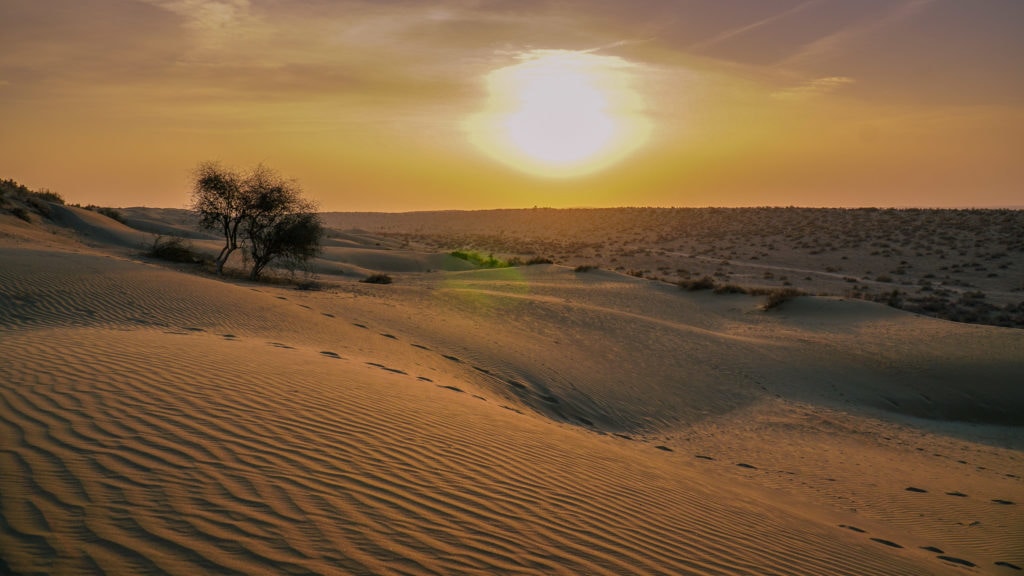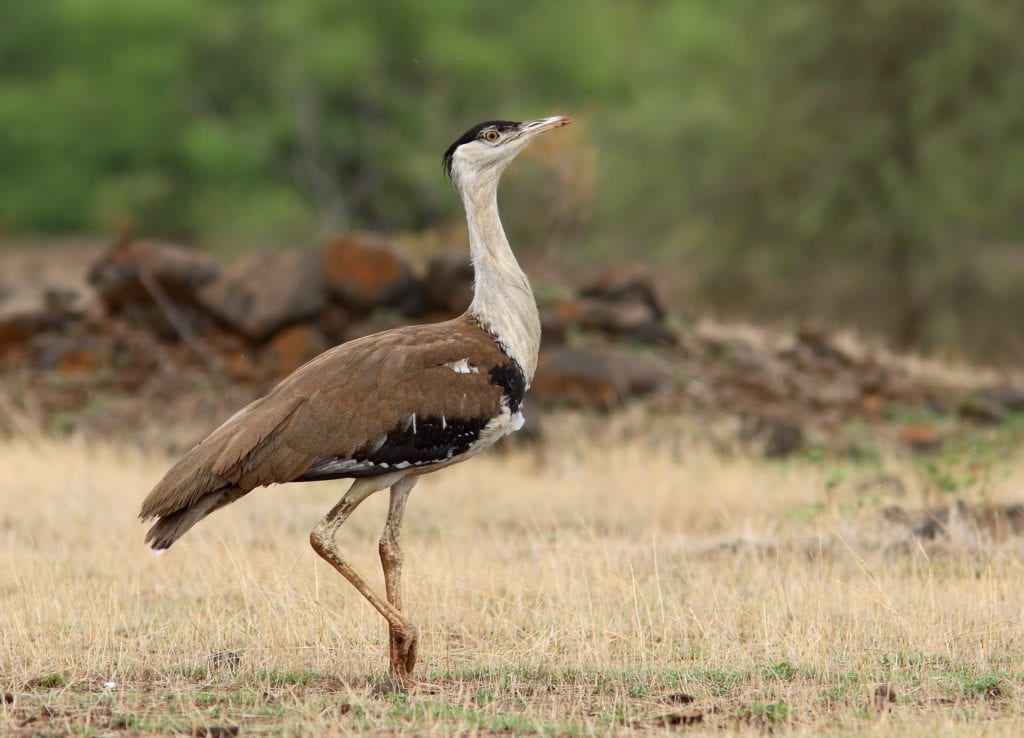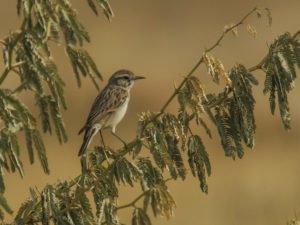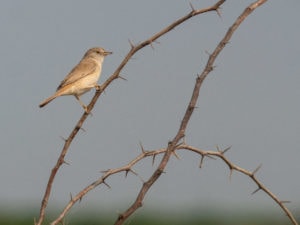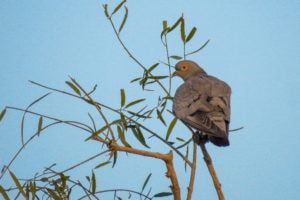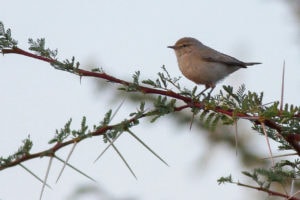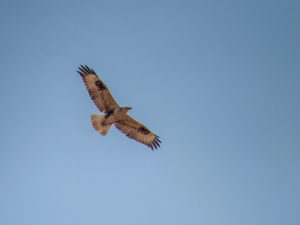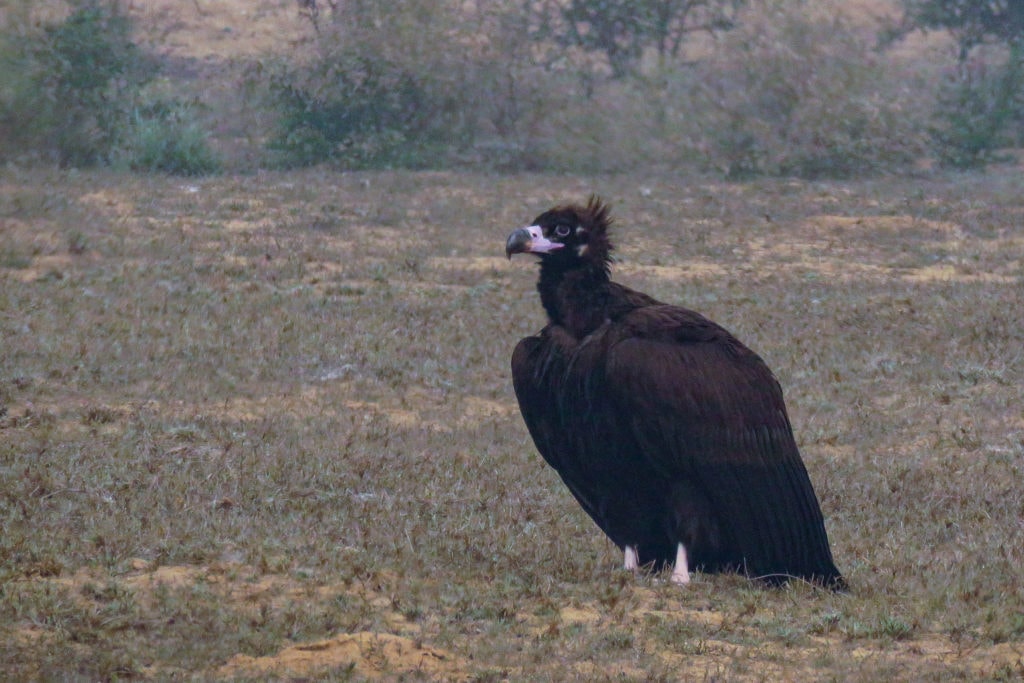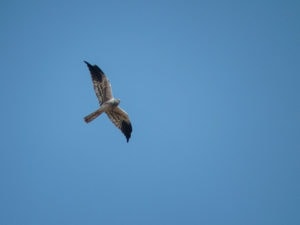Location and Habitat
Desert National Park (DNP) is located in Western Rajasthan, very close to the border with Pakistan. The larger Thar Desert landscape encompasses an area of 200,000 sq. km, much of which falls within Rajasthan. The Desert National Park, denoted in 1980, comprises an area of 3,162 sq.km in Jaisalmer district, and is an Important Bird Area and tentative addition to the list of UNESCO World Heritage Sites.
One of the largest and the richest arid and semi-arid regions in the country, DNP has several kinds of habitats including grasslands, scrublands, farms, water bodies, rocky terrains, etc. Land-use change and other development activities have, however, transformed the landscape, its biodiversity and people to a great extent.
| Hotspot | Desert National Park |
| District | Jaisalmer |
| Other hotspots | Desert NP–Sudasari Akal Wood Fossil Park Kuldhara Netsi Lake |
| Checklist | Rajasthan |
Birding
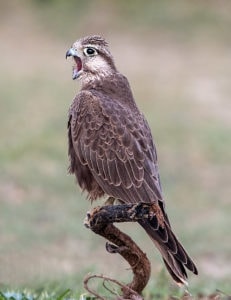
Desert National Park boasts at least 253 species of birds, with 310 from the overall Jaisalmer district. Having a diversity of habitats, the landscape gives a great opportunity to tick off a long list of species, including several difficult to find elsewhere.
One of the most common features of this landscape is undoubtedly the scores of larks—mostly Greater Short-toed, but often with many Bimaculated and sparrow larks, including Black-crowned—flying in huge flocks (often numbering in the 1000s!), giving the appearance of a ‘bird wave’. I was particularly bowled over by this sight in almost every part of the landscape I visited.
Bird watching starts off right from the road from Jaisalmer to Sam. Being a matrix of arid land and farmlands, with few scattered settlements, this section is ideal for ticking off commoner birds such as Common Babbler, White-eared Bulbul, Common Kestrel, Egyptian, Red-headed and Cinereous Vulture, Laggar Falcon, wheatears—Isabelline, Desert, and Variable (all three subspecies possible), Rufous-tailed Lark, Ashy- and Black-crowned Sparrow Larks, “Punjab” Northern Raven, etc.

Sudasari is undoubtedly one of Desert National Park’s best kept birding spots. It is most famed for the Great Indian Bustard populations in this area. Make sure to spend an entire day in and around this area for this extremely endangered species. The “GIB” is tied to mostly open grassland, scrublands and agricultural fields. Fenced enclosures built in several parts of DNP enable a predator-proof area for the bustards to breed and forage, and are thus the ideal locations for sighting them.
Read the fascinating story of Sukhpali, the first female forest guard who helps protect this area.
As well as Great Indian Bustard, look for Macqueen’s Bustard, Cream-coloured Courser, and the elusive White-browed (Stoliczka’s) Bushchat. Scan the bushes and scrub for Asian Desert Warbler, Eastern Orphean Warbler, and Desert Lesser Whitethroat.
Other specialities, including Indian Eagle-Owl, Graceful and Rufous-fronted Prinias, Water and Buff-bellied Pipits, Bimaculated Lark and Greater Hoopoe Lark, can also be found here, whilst Hypocolius, Red-tailed and “Steppe” Great Grey Shrike, are possible.
Yellow-eyed Pigeon used to be found here in flocks of thousands, but it is no longer a guaranteed sighting—fortunately other sites nearby in Rajasthan are still reliable.
One can drive beyond Sudasari to Khuri, which can be a good site for numerous vultures, as well as the increasingly scarce Plain Leaf Warbler.
Recently, India’s first confirmed Finsch’s Wheatear, and the only recent record of the probably overlooked Sind Woodpecker, have been reported from Desert National Park and surroundings.
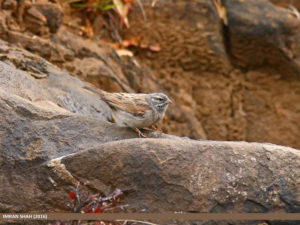
Kuldhara, famous for its abandoned (and haunted?!) village and rocky terrain, is another area of habitat worth checking. Look for Trumpeter Finch, Desert Lark, Red-tailed Wheatear, Striolated Bunting, and pipits, especially Long-billed and Tawny.
There is an outstanding diversity of raptors throughout much of Desert National Park—including Pallid and Montagu’s Harriers, Laggar Falcon, Common Kestrel and the rare Lesser Kestrel, Merlin, Steppe Eagle, Tawny Eagle, Eastern Imperial Eagle, Short-toed Snake Eagle, and Long-legged Buzzard. This area is one of the better places to still find vultures in reasonable numbers—Himalayan and Eurasian Griffons, Cinereous Vulture, Red-headed Vulture, Egyptian Vulture, White-rumped Vulture and Indian Vulture, are all possible with a little luck.
Netsi Talab (lake) is a waterbody that attracts a range of waterbirds such as Garganey, Mallard (a scarce bird in India), Black Stork, and many waders—Common and Spotted Redshank, Kentish and Little Ringed Plovers, Common Greenshank, various sandpipers, Black-winged Stilts, Yellow-wattled Lapwing, Ruff, etc. Other specialities like the Demoiselle Crane, Common Crane, and Cream-coloured Courser, can also be seen. Careful checking of any Water Pipits here may well produce some of the rarer Buff-bellied Pipits.
Some waterbodies in the desert are the key haunt of sandgrouse, and Netsi is usually the best area. Like clockwork, these birds visit to drink water in large flocks. Chestnut-bellied Sandgrouse is by far the commonest, although lucky ones can spot the elusive Black-bellied Sandgrouse and Spotted Sandgrouse. Birdwatchers often wait it out near the waterbodies for the sandgrouse to arrive. However, they are extremely cautious of human presence and thus, it is important to keep a good distance. A good pair of binoculars and a spotting scope are ideal as Black-bellied and Spotted are usually seen with a larger group of Chestnut-bellied Sandgrouse, and may be difficult to pick out—particularly as the chestnut belly often looks black at a distance!
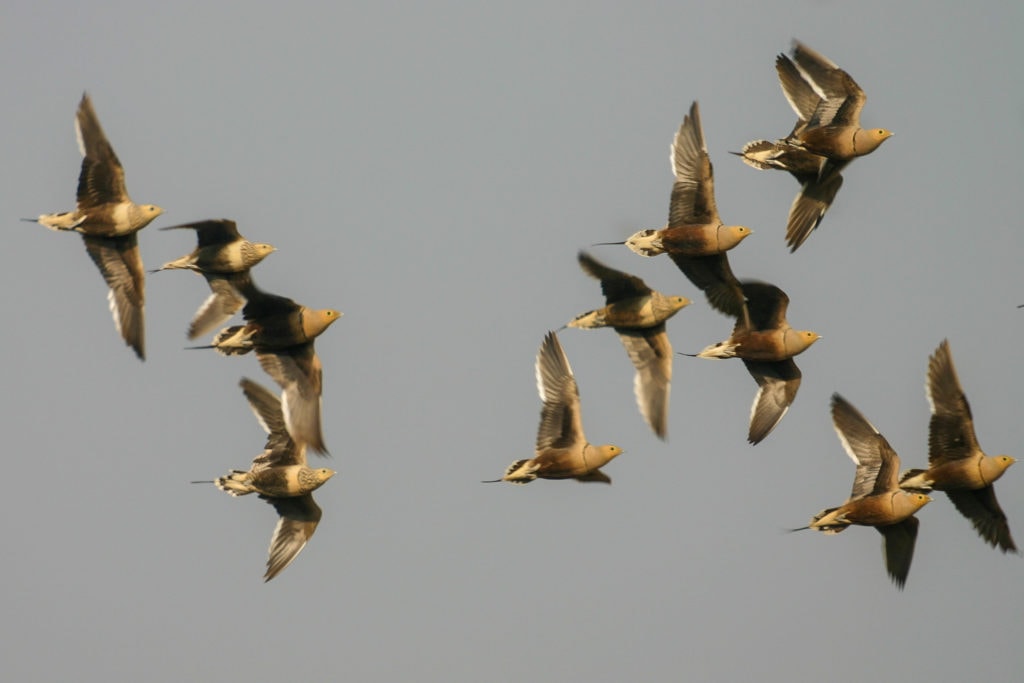
Other Wildlife
While birds are certainly a highlight for anyone visiting the Desert National Park, the vast expanses of the Thar desert have a rich biodiversity for the keen-eyed. The mammal diversity of the Thar landscape includes Chinkaras (Indian Gazelle), Desert Jird, and Desert Fox, which are relatively common and are usually found in most areas. People lucky enough can also spot the elusive Desert Cat and Indian Hedgehog. For those interested in reptiles and amphibians, the Thar offers a stunning variety of these fascinating life-forms with at least eight species of amphibians and 51 reptiles. Targets include the famed Spiny-tailed Lizard (known as “Saanda“), Saw-scaled Viper, Persian Dwarf Gecko, Toad-headed Agama, Indus Valley Toad, etc. There is also a wide range of scorpions.
Logistics
Weather and Timing
The Desert National Park can be accessible throughout the year. However, the best time to visit the park is definitely the winter, particularly October to February. For one, it isn’t hot (temperatures can touch 50 degrees Celsius in summer!), thus offering a much more relaxed birding session. Winter nights in the desert get very cold, sometimes dropping to well below freezing temperature. This cold continues well into the morning, sometimes accompanied by dense fog. Winter is great for most of the migratory species that turn up here, especially the raptors, larks, wheatears and speciality species including Cream-coloured Courser, Macqueen’s Bustard, as well as sandgrouse. Since winters can be harsh, one is recommended to carry thick layers, as well as glasses and hats to protect against wind and the occasional sandstorm.
Mobile network coverage is fairly good, although there will be a few black spots when travelling deeper inside the sanctuary. Be sure to carry lots of water whenever out birding, as one can quickly get dehydrated.
Monsoon and post monsoon season (July through to September) is the passage season, with species like Rufous-tailed Scrub Robin, Blue-cheeked Bee-eater, European Roller, European Nightjar, Spotted Flycatcher, Common Whitethroat, and Red-backed Shrike, in abundance. These are all rarely encountered elsewhere in India, or at other times of year, hence an autumn trip here is popular with Indian listers. However, be warned that being the breeding season for the Great Indian Bustard, photography is not allowed, and travel may be restricted.
Summer months are notoriously difficult times for birding, as it is very hot and bird activity is very limited, but there is always scope for finding the unexpected!
Getting There
The nearest town to serve as a gateway to Desert National Park is Jaisalmer, situated in west Rajasthan. The town is served by an airport and a railway station, and one has the option to either take a flight or a train. However, Jaisalmer Airport is operational at only certain times of the year and thus, flying to Jodhpur is a more reliable option. If it is part of a longer trip, people also drive in from Delhi, making pit stops at Jaipur, Jodhpur, Bikaner and Jaisalmer.
Accommodation and Food
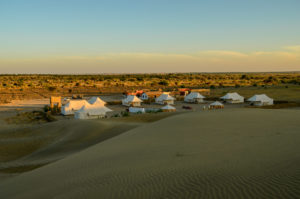
It is recommended that one hires a vehicle during the span of their stay. The vast expanse of the national park warrants long distance drives to get to different parts of the area. The village of Sam is the most convenient place to stay, as it provides close proximity to the main birding locations, and allows an early start to the day. Sam village has plenty of options to stay, including the Chokhi Dhani Desert Camp, KK Resorts and Camps, etc. There are several other camps within a wide price range, with accommodation in Swiss tents or cottages. Prices typically range between ₹3,000-7,000 per day. At Sam, one can also enjoy the Sahara-like stretches of sand dunes.
Sam is also the location where the Forest Department of Rajasthan, in collaboration with the Wildlife Institute of India, have set up a Great Indian Bustard Breeding centre intended to repopulate the species from the brink of extinction. The centre is, however, not accessible for visitors.
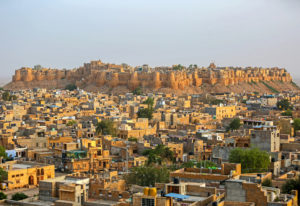
Jaisalmer is another option for a stay, but that does mean an extra hour of drive to reach the birding spots. It is ideal though for combining birding with some of the best of Rajasthan’s culture and heritage, and has several accommodation options, including luxury hotels. These places also offer an authentic experience for their guests, with cultural evenings of music and dancing, local food, and handcrafted souvenirs. While at Jaisalmer, one should also visit the highly-famed Jaisalmer Fort—sometimes christened the Golden Fort “Sonar Qila”. There are many options for combining birding with an unforgettable cultural and historic holiday, such as the amazing Colours of Rajasthan and Forts & Palaces of Rajasthan tours.
Rajasthan is very famous for its food. Do try out their popular Ker-Sangri, a dish made out of Ker berries Capparis decidua and Sangri Prosopis cineraria, two plants that grow in the deserts and grasslands with very little rainfall.
Other Areas of Interest
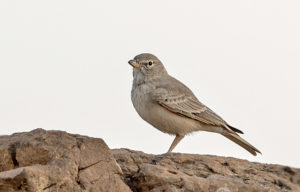
Near Desert National Park, is the Akal Wood Fossil Park. Lying in the Jaisalmer Fossil Belt, it has fossilised tree trunks dating back to 180 million years ago! The rocky habitat is good for bird watching, particularly for Desert Lark, Red-tailed Wheatear, and Trumpeter Finch. This used to be an almost guaranteed site for Plain Leaf Warbler, although sightings have become less reliable in recent years.
Other than Desert National Park, most visits to this part of India will include other major birding sites such as those near Bikaner, and Tal Chhapar.
Bikaner has the famed Jorbeer Conservation Reserve that plays hosts to numerous species of raptors including Cinereous Vulture, Himalayan and Eurasian Griffons, Egyptian Vulture, Indian Vulture, Red-headed Vulture, White-rumped Vulture, Steppe Eagle, Tawny Eagle, Eastern Imperial Eagle, and Laggar Falcon, with a chance of rarer species such as Saker Falcon and White-tailed Eagle. In winters, several thousand raptors should be present, giving wonderful photographic opportunities. The “Punjab” subspecies of Northern Raven, Sociable Lapwing, Cream-coloured Courser, White-browed (Stoliczka’s) Bushchat, and flocks of Yellow-eyed Pigeons—at one of their last strongholds—may all be seen with a little luck.
Tal Chhapar, in Churu District, is another small patch of grassland that is most famous for Indian Spotted Creeper, although many of the species mentioned above can be seen as well. It is particularly good for Indian Eagle Owl, Lesser Kestrel, White-eyed Buzzard, good numbers of Montagu’s and Pallid Harriers, Stoliczkzka’s Bushchat, plus passage migrants in the autumn.
Conservation Concerns
One of the chief conservation concerns of the entire landscape of Desert National Park is that of habitat loss and degradation. In spite of the rich biodiversity that is harboured by grasslands and scrublands, these habitats are regarded as wastelands, and thus do not come under the purview of conservation efforts by the government. Rapid greening in a bid to end ‘desertification’ has caused significant habitat loss.
In addition to this, the installation of multiple power lines in the entire landscape has caused massive mortality events for birds, including the Great Indian Bustards. Free-ranging dogs have also aggravated biodiversity loss, and ongoing research and documentation have observed the need to control their population.
Being one of the largest swathes of grassland habitat in India, the DNP landscape requires urgent conservation efforts that benefit both biodiversity as well as local communities, who have been stewards in conservation of these habitats for generations.
Useful Trip Reports
- Birding Trip Report: Desert National Park, Pritam Baruah—mid-December birding report to most of the sites mentioned above
- Desert National Park, Dr Ian D’Souza—DNP birding travel experience, complete with excellent photos (and a sandstorm!)
- Rajasthan and Harike, Lieven De Temmerman—detailed report of a short trip targeting Great Indian Bustard and other Rajasthan specialities
Desert National Park is one of the highlights of our main Northwest India birding tour, and also the focus of our short Great Indian Bustard tour. It can also be done as a specific short birdwatching break.
